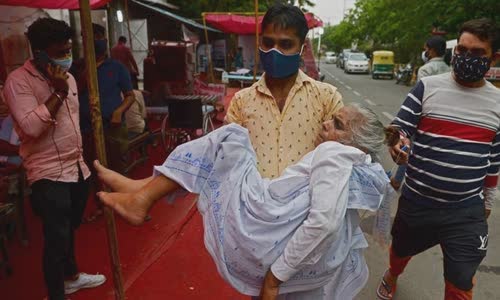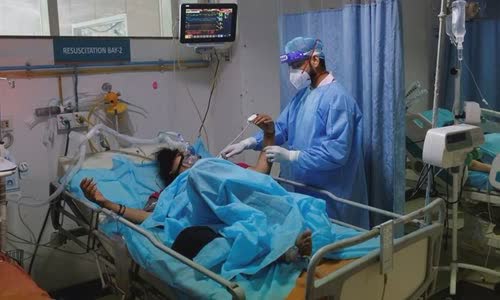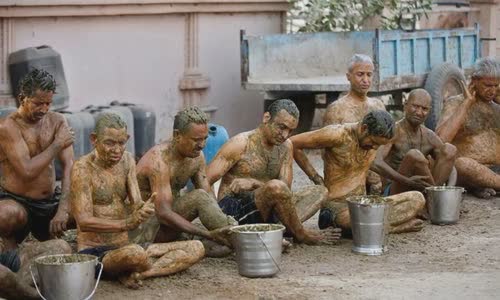The government underestimates the disease and lacks a reasonable distribution mechanism that causes many Indians to infect NCOV to die without an oxygen to breathe.
Three weeks, more than 68 trains carrying 4,200 tons of liquid oxygen from production states like Gujarat, Andhra Pradesh, Odisha, Jharkhand or West Bengal to the lack of cities, like New Delhi, Lucknow and Bangalore.

Photo: AFP.
Oxygen number is equivalent to 46% of national needs, but because these cities are facing a terrible increase in Covid-19 infections, they are never enough.
Patient Covid-19 was carried by the house to a free oxygen supply location in the capital of New Delhi, India.
Oxygen manufacturers said they increased production to 10 times, while New Delhi asked all industrial oxygen factories to switch to medical oxygen production.
The Indian army also provides cold tanks, oxygen generators, generators and drugs provided from countries like Singapore, Australia, France, England or the United States.
However, 7 weeks after the second Covid-19 waves attacked India, patients died at the hospital because no oxygen breathing was still very popular.
India seemed to fail in the effort to restrain Covid-19 that made critics to ask why a nuclear power, the industrial power was up as they could not take strong measures.
Narendra Modi Prime Minister is being sued in courts in many places because of a series of reasons, from the shortage of oxygen supply to questions about vaccine policy.
Vikas Bajpai, Associate Professor at the Center for Social Medicine and Community Health, Jawaharlal University Nehru, Evaluation of Prime Minister Modi's government in fact still makes his best.
"How can a country fight a pandemic based only on the charity of a few good people without any clear strategies or the governments' readiness and determination in implementing measures
In a document sending to the Supreme Court on May 11, the Modi government warned that "all excessive judicial intervention actions, even though it is good, it can cause consequences, including work
K.e.
Currently, more than 54.4% of Covid-19 patients in hospitalization need oxygen support, higher than the first infection waves peaking in the period from September to November last year.
According to a government official, 11 people died at a public hospital in Tirupati, the city of Andhra Pradesh, south of India, late at 10/5 due to late oxygen tank trucks.

Photo: Reuters.
But Siddharth Jain, Air Products CEO Air Products, the company claimed to be the largest oxygen production unit in the country, said India tried to increase the output from 7,200 tons to about 9,200 tons in April.
Health workers take care of Covid-19 patients in a hospital in New Delhi.
Jain said the cause of sending oxygen to the capital New Delhi was delayed because the states produced they need to meet the local needs before.
So, while India has enough infrastructure to produce and distribute oxygen to respond to current infections, the allocation of them in the right direction takes too much time.
Raghunathan agrees that the increase in cases has made manufacturers in the private sector overloaded.
Munjal Mehta, Director Shell-n-Tube, India's leading frozen equipment manufacturer, said in normal times, if a liquid medical oxygen producer wants to provide oxygen for 5 hospitals, they
But now the manufacturer needs to transport oxygen to both hospitals every day, while they do not have enough dedicated trucks.
The demand for oxygen tank trucks has increased 5 times, but manufacturers cannot invest to produce 5 times a lot of cars, Mehta said.
It is also unclear whether the plan to build 100 oxygen plants announced by the Government in April has a reality or not.
According to Sanjay Jaiswal from Airox Technologies, one of the companies won 42 factories last year, he transferred 35 factories to the government but the remaining 7 establishments were not ready.
Ragunathan emphasized the biggest question for private enterprises when considering increasing production capacity or establishing new facilities "Who will support long-term costs when the crisis ends?".
"The public sector needs to play a key role in the production of oxygen for health care," he said.
The number of Covid-19 cases began to increase from February when Prime Minister Modi and the Minister of Interior Amit Shah held political mobilization meetings in many states.

Photo: Reuters.
Kumbh Mela Religious Festival, takes place in March and April, witnessing 3.5 million people flowing from all over India, many of them do not wear masks.
President of the Indian Federation Harsh Mahajan called this "super-infectious events", adding that they also created a feeling of complacency in the public, causing many people to think of being alert.
The Indian government also ignored a 190-page report from the National Assembly warning from November last year of the second infection, and raised the situation of "lack of hospital beds" and "not enough breathing machines"
And when international aid to India last month, shipments were stuck for more than a week at the airports due to bureaucracy.
Critics also asked why the Modi government did not issue an emergency in the whole country, imposing a blockade or moving the military to support the operation of health facilities.
T Sundararaman, former director of the national health resource system, an advisory agency for the Indian Ministry of Health, believes that the government still has to "struggle" with a number of sudden infections and "no
Complexing the situation is that a deadly black mushroom or Mucormycosis, silently attacking Indians, especially Covid-19 patients, making the current crisis even worse.
"Mucormycosis mortality rate is 50%, while the mortality rate for Covid-19 is only 2.5%," said Amarinder Singh Malhi, who worked at the Indian Institute of Health Sciences, a public hospital
India's vaccination campaign also has many problems.
Reuters predicted at the current speed, India takes 2.8 years to take two doses of Covid-19 vaccine for 75% of the population.
Associate Professor Bajpai called on the Government to quickly prevent storage or trade in the black market Oxygen and Covid-19 drugs such as Remdesivir, while ensuring these items are always available at the original price
Government officials are also criticized for proposing non-scientific methods to fight viruses.
The believers on the outskirts of the city of Ahmedabad, India, apply cow to people with faith who helps to chase Covid-19.
In a recent statement, Jan Swastthya Abhiyan, a movement of people who work for health benefits, asked Prime Minister Modi to better organize the provision and distribution of oxygen without interruption to the disease



 Cyndi Wayward
Cyndi Wayward







